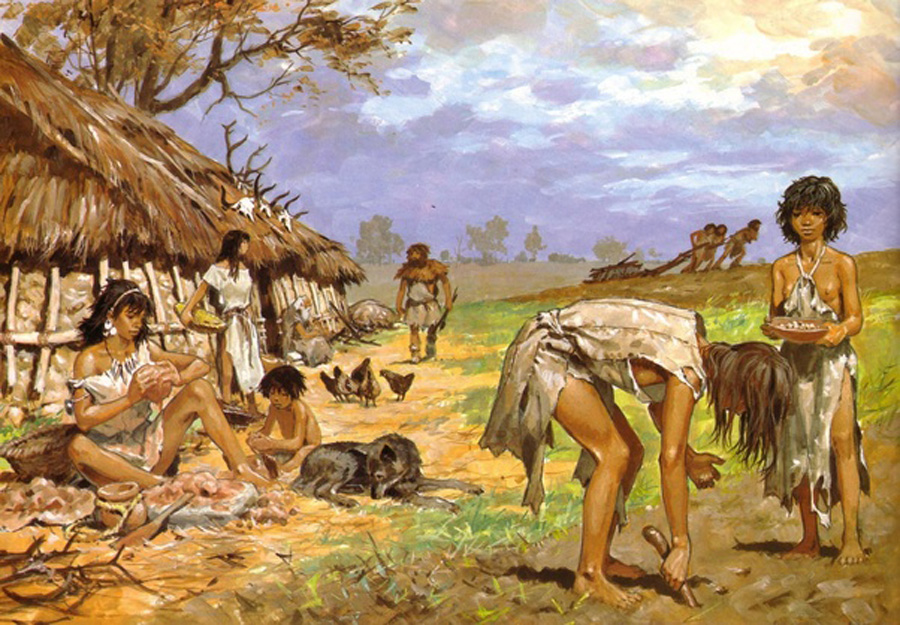North and South America were the last landmasses in the world to gain human inhabitance. The Native Americans did not arrive on the continent of North America by sailing there in ships from across the ocean. They walked to get to the Americas.
the first Native Americans arrived in Alaska
from Siberia less than 23,000 years ago
Although they took their time, over several thousand years, their ancestry is traced to both east Asian and western Eurasians that made their way from eastern Siberia into a new world at present-day Alaska around 40,000 years ago. The remains of an 11,500-year-old infant found by archaeologist reveal an Ice Age civilization in Fairbanks, Alaska
Asian and western Eurasians – Upward Sun River camp in Alaska
The Paleo people were hunger-gatherers that crossed into North America via Beringia, a land mass now under the ocean waters of the Bering Strait. Humans and animals could simply walk from Asia to North America.
Paleo Indian culture – Paleo Indians caribou hunting
The people living there would have had no idea that it was a land bridge at all. Native Americans likely arose from a single population of people who had lived in Beringia, isolated for many years.
Beringa land bridge
Beringia was also an ideal environment for large grazing mammals, giving early hunter-gathers something to hunt. Some of them probably followed the herds of bison, mammoth, and caribou across this land bridge, they were the first “big-game hunters.”
the hunter games
Melting ice made an open corridor, full of mud, ice and slush, allowing man and animals to travel a miserable journey south.
North American Indian migration
Others may have followed along the coast on shelf or sheet ice, and they may have traveled in small primitive boats along the northern Pacific.
primitive boats
The migration spread first along the coast then eastward. They were the first immigrants to the New World and they brought with them a culture that spawned into civilizations like the Iroquois in North America and the Piraha of South America.
Iroquois longhouse
Over time, melting ice raised the sea level covering the land bridge and separating the human and animal population of the Old World with the New World. The Native Americans lost many of the immunities to diseases their ancestors had possessed. Several thousand years later the first complex civilizations arose as hunter-gathers settled into semi-agricultural communities.
hunter-gathers to farmers
Most Native Americans today are direct descendants of the Clovis people who settled across North America about 13,000 years ago. There is evidence of early human activity in the stone tools, spear and arrow heads, and scrapers that have been found by archaeologists. These hand- crafted lithic flaked tools are used to classify cultural periods. The earliest definitively-dated Paleo-Indians was the Clovis culture.
Clovis named for the first significant archaeological site found in 1929 near Clovis
Native Americans were isolated from peoples of the, “Old World” until about the 10th century when Norsemen explored and settled areas of North America.
Viking voyages to the new world
When Christopher Columbus landed in the New World he was in search of India and thought he had arrived in the East Indies. These islands were known as the “West Indies”, which let to the blanket term “Indies” and “Indians”, which implied racial or some kind of cultural unity among the indigenous peoples of the Americas.
the voyages of Christopher Columbus
The European colonization of the Americas fundamentally changed the lives and cultures of the native peoples.
the colonization of the Americas – map of settlements
Within the first century of contact with the Europeans the Native American population diminished 80% and 90%. The Europeans brought diseases with them, like cow pox, they had acquired from their domesticated animals that the Native Americans did not have access to. Native American tribes were decimated from Afro-Eurasian diseases.
Native American decimated by Afro-Eurasian diseases
The Tainos of Hispaniola were the first indigenous group Columbus encountered, and within thirty years 70% of them had died. Afro-Eruasian disease outbreaks, like measles, smallpox and cholera ravaged their population because they had no immunity to the sickness. Early explorers and African slaves brought them from Europe. Central Africans slaves, who like the Native Americans lacked any resistances to the diseases of Europe and Northern Africa.
Bartholomew Columbus’s cruel destruction in Hispaniola
The tribes were punished for revolting against forced labor and religious education, this led to the last great Taino rebellion in 1511. Sadly, after years of mistreatment, the Taninos adopted suicidal behaviors. The men were jumping off cliffs to their death or eating untreated cassava, a violent poison. And some women were aborting or killing their infants to save them from a life of slavery.
Taino native peoples chose death over slavery
Soon after the voyages of Columbus, Spanish, Portuguese, and later English, French and Dutch sent colonial expeditions to the New World. They occupied and settled on the new discovered Indian homeland.
Discovery and settlement of the New World
Spain lay claim from the southwest, down through Florida and the Caribbean all the way to the southern most tip of South America.
the southwest and Caribbean was claimed by Spain
Martin Afonso de Sousa founded the first permanent Portuguese settlement, Captaincy of Sao Vicente, in the Americas what was called “Port of the Slaves” in 1532. They trafficked in slaves captured by allied tribes.
Martin Afonso de Sousa – Early map of Brazil -São Vicente
English warships attempted to trade with the Portuguese settlement, but they were attacked by three Spanish galleons only to be repelled by the English ships sinking one Spanish galleon in the battle.
English repelled Spanish galleons
TIME LINE – The Native American story part 2
>>to return to previous page – right click on back arrow <<
Word count: 952







































